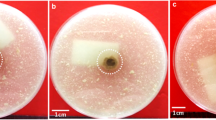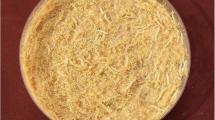Abstract
Lichens are characterized by a great variety of secondary metabolites. The function of these substances remains partly unknown. In this study, we propose that some of these metabolites may expel insect herbivores. To test this hypothesis, we reared larvae of the lichenivorous moth Cleorodes lichenaria on three selected lichens, Cladonia arbuscula subsp. mitis, Usnea hirta, and Usnea dasypoga. In experimental setup, the secondary metabolite usnic acid was removed from the lichens with acetone prior to feeding, whereas a control was left untreated. On all three lichens, removal of usnic acid from the lichens using acetone significantly prolonged survival of larvae and increased their viability. Larvae reared on control lichens contained significantly more usnic acid than those reared on treated lichens, both in their biomass and their faeces. These results support the hypothesis that usnic acid serves as a repellent against insect feeding, besides its well established functions of UV protection and antimicrobial properties.






Similar content being viewed by others
References
Asplund J, Wardle DA (2013) The impact of secondary compounds and functional characteristics on lichen palatability and decomposition. J Ecol 101:689–700
Asplund J, Bokhorst S, Kardol P, Wardle DA (2015) Removal of secondary compounds increases invertebrate abundance in lichens. Fungal Ecol 18:18–25
Bačkor M, Klemová K, Bačkorová M, Ivanova V (2010) Comparison of the phytotoxic effect of usnic acid on cultures of free-living alga Scenedesmus quadricauda and aposymbiotically grown lichen photobiont Trebouxia erici. J Chem Ecol 36:405–411
Blewitt MR, Cooper-Driver GA (1990) The effects of lichen extracts on feeding by gypsy moth (Lymantria dispar). Bryologist 93:220–221
Culberson CF, Culberson WL, Johnson A (1977) Second supplement to chemical and botanical guide to lichen products. The American Bryological and Lichenological Society, Missouri Botanical Garden, St. Louis
Emmerich R, Giez I, Lange OL, Proksch P (1993) Toxicity and antifeedant activity of lichen compounds against the polyphagous herbivorous insect Spodoptera littoralis. Phytochemistry 33(6):1389–1394. doi:10.1016/0031-9422(93)85097-B
Fahselt D (1994) Secondary biochemistry of lichens. Symbiosis 16:117–165
Feige GB, Lumbsch HT, Huneck S, Elix JA (1993) The identification of lichen substances by a standardized high-performance liquid chromatographic method. J Chromatogr 646:417–427
Gauslaa Y (2005) Lichen palatability depends on investments in herbivore defence. Oecologia 143(1):94–105
Gerson U, Seaward MRD (1977) Lichen-invertebrate associations. In: Seaward MRD (ed) Lichen ecology. Academic Press, London, pp 69–119
Giez I, Lange OL, Proksch P (1994) Growth retarding activity of lichen substances against the polyphagous herbivorous insect Spodoptera littoralis. Biochem Syst Ecol 22:113–120
Hauck M, Huneck S (2007) Lichen substances affect metal absorption in Hypogymnia physodes. J Chem Ecol 33:219–223
Hauck M, Willenbruch K, Leuschner C (2009) Lichen substances prevent lichens from nutrient deficiency. J Chem Ecol 35:71–73
Hawksworth DL, Kirk PM, Sutton BC, Pegler DN (1995) Ainsworth and Bisby’s dictionary of the fungi, 8th edn. CAB International, Wallingford, p 616
Hyvärinen M, Crittenden PD (2000) 33P translocation in the thallus of the mat forming lichen Cladonia portentosa. New Phytol 145:281–288
Ingólfsdóttir K (2002) Usnic acid. Phytochemistry 61(7):729–736
Larson DW (1987) The absorption and relase of water by lichens. In: Peveling E (ed) Progress and problems in lichenology in the eighties. Bibliotheca Lichenologica 25, J. Cramer, Berlin-Stuttgart, pp 351–360
Lawrey JD (1983) Lichen herbivore preference: a test of two hypotheses. Am J Bot 70:1188–1194
Lawrey JD (1986) Biological role of lichen substances. Bryologist 89:111–122
Orange A, James PW, White FJ (2001) Microchemical methods for the identification of lichens. British Lichen Society, London
Pöykkö H (2005) Host range of Lichenivorous Moths with special reference to nutritional quality and chemical defence in lichens. Ph.D. dissertation, Oulu University press
Pöykkö H (2006) Females and larvae of a geometrid moth Clerodes lichenaria prefer a lichen host that assures shortest larval period. Environ Entomol 35:1669–1676
Pöykkö H (2011a) Host growth form underlies enemy-free space for lichen-feeding moth larvae. J Anim Ecol 80:1324–2329
Pöykkö H (2011b) Enemy-free space and the host range of a lichenivorous moth: a field experiment. Oikos 120:564–569
Pöykkö H, Tammaru T (2010) Countergradient versus cogradient variation in growth and diapause in a lichen-feeding moth, Eilema depressum (Lepidoptera: Arctiidae). J Evol Biol 23(6):1278–1285
Pöykkö H, Hyvärinen M, Bačkor M (2005) Removal of lichen secondary metabolites affects food choice and survival of lichenivorous moth larvae. Ecology 86(10):2623–2632
Pöykkö H, Bačkor M, Bencúrová E, Mocanová V, Bačkorová M, Hyvärinen M (2010) Host use of a specialist lichen-feeder: dealing with lichen secondary metabolites. Oecologia 164(2):423–430
Reutimann P, Scheidegger C (1987) Importance of lichen secondary products in food choice of two oribatid mites (Acari) in an alpine meadow ecosystem. J Chem Ecol 13:363–369
Slansky F (1979) Effect of the lichen chemicals atranorin and vulpinic acid upon feeding and growth of larvae of the yellow—striped armyworm, Spodoptera ornithogalli. Environ Entomol 8:865–868
Solhaug KA, Gauslaa Y (1996) Protective role of parietin against high light in the lichen Xanthoria parietina. Oecologia 108:412–418
Solhaug KA, Gauslaa Y (2004) Photosynthates stimulate the UV-B induced fungal anthraquinone synthesis in the UV-B induced fungal anthraquinone synthesis in the foliose lichen Xanthoria parietina. Plant Cell Environ 27:167–176
Solhaug KA, Lind M, Nybakken L, Gauslaa Y (2009) Possible functional roles of cortical depsides and medullary depsidones in the foliose lichen Hypogymnia physodes. Flora 204:40–48
Stahl GE (1904) Die Schutzmittel der Flechten gegen Tierfrass. In: Festschrift zum sibenzigsten Geburstage von Ernst Haeckel. Fischer, Jena, pp 357–375
Stephenson NL, Rundel PW (1979) Quantitative variation and the ecological role of vulpinic acid and atranorin in the thallus Letharia vulpina (Lichenes). Biochem Syst Ecol 7:263–267
Zukal H (1895) Morphologische und biologische Untersuchungen über die Flechten II. Sitzungsberichte der Kaiserlichen Akademie der Wissenschaften. Mathematisch-Naturwissenschaftliche Classe 104:1303–1395
Acknowledgments
This work was financially supported by Slovak Grant Agency (VEGA 1/1238/12). Thanks are expressed to Ass. Prof. Mag. Dr. Ingeborg Lang (Core Facility Cell Imaging and Ultrastructure Research, University of Vienna) for critical reading and reviewing this manuscript.
Author information
Authors and Affiliations
Corresponding author
Additional information
Handling Editor: Jarmo Holopainen.
Rights and permissions
About this article
Cite this article
Goga, M., Pöykkö, H., Adlassnig, W. et al. Response of the lichen-eating moth Cleorodes lichenaria larvae to varying amounts of usnic acid in the lichens. Arthropod-Plant Interactions 10, 71–77 (2016). https://doi.org/10.1007/s11829-015-9409-5
Received:
Accepted:
Published:
Issue Date:
DOI: https://doi.org/10.1007/s11829-015-9409-5




